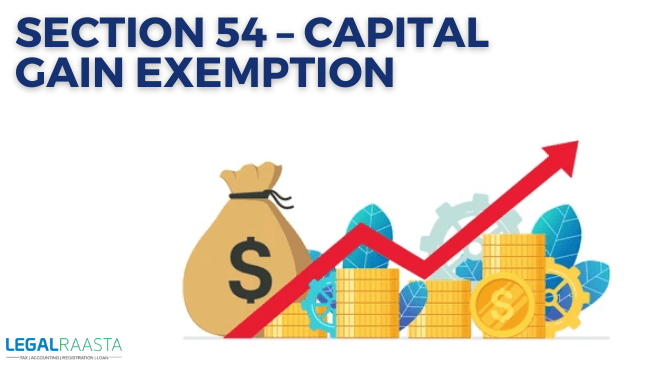Section 54 – Capital Gain Exemption: A residential home sale is a capital asset sale, and the profit is taxed as a capital gain.
Property of any sort, moveable or immovable, tangible or intangible, owned by the assessee for whatever purpose is included in the definition of capital asset under section 2(14) of the Income Tax Act.
Assets are categorized into two classes for capital gains purposes under the income tax statute, depending on how long they have been held:
- Short-term capital asset
Short-term capital assets are those that are held by an individual for less than 36 months. Short-term capital gains are the profits made from the selling of these assets.
- Long-term capital asset
Long-term capital assets are those that have been kept by the assessee for more than 36 months. Long-term capital gains are the profits made from the sale of these assets.
What are the advantages of categorizing an asset as a long-term capital asset?
Contents
- What are the advantages of categorizing an asset as a long-term capital asset?
- Exemptions under Section 54
- What is the amount of Exemption available under Section 54 of the Income-tax Act?
- What are the provisions for the transfer of property after claiming Section 54 benefits?
- What is a Capital Gains Account Scheme, and how does it work?
- Section 54 vs Section 54f
- Difference between section 54 and section 54F
- Conclusion
The main advantage of classifying an item as a long-term capital asset is that the assessee is qualified for indexation. Furthermore, some exemptions are only applicable to long-term capital assets.
Exemptions under Section 54
If the capital gains from the sale of a residential property are invested in the acquisition or building of a residential property, an individual or HUF can benefit from tax exemptions under Section 54 of the Income Tax Act.
Section 54 does not apply to taxpayers such as partnership firms, LLPs, corporations, or any other association or body. The following are the conditions that must be met in order to benefit from the said section:
- The asset sold is a Residential House, and it must be classed as a long-term capital asset. The income from such a house should be taxed as House Property Income.
- A residential house shall be purchased by the seller either one year before or two years after the date of sale/transfer. If the seller is building a house, the seller has more time, i.e. the seller has three years from the date of sale/transfer to complete the residential dwelling. The time of acquisition or construction shall be established from the date of receipt of compensation (whether original or extra compensation) in the case of compulsory acquisition.
- The new residential dwelling must be located in India. The seller cannot claim the exemption if he or she buys or sells a home in another country.
The conditions listed above are cumulative. As a result, even if one of the conditions is not met, the seller is not eligible for the Section 54 exemption.
A capital gain exemption is offered for the acquisition of two residential residences in India beginning in Assessment Year 2020-21, which corresponds to FY 2019-20. However, the capital gain must not exceed Rs 2 crore to qualify for the exemption. Furthermore, the exemption is only granted once during the seller’s lifetime.
What is the amount of Exemption available under Section 54 of the Income-tax Act?
The amount of the long-term capital gains exemption under Section 54 of the Income Tax Act will be the lesser of:
Long-term planning Capital profits arising from the sale or building of a new residential house property, or capital gains arising from the sale or construction of a new residential house property.
As a result, any remaining capital gains (if any) will be taxable.
What are the provisions for the transfer of property after claiming Section 54 benefits?
If the new house is sold within three years of its acquisition or construction, the exemption claimed under section 54 will be indirectly taxable in the year of the new house’s sale. Consider the following two scenarios in which a new house is sold within three years of its acquisition or construction:
Case 1: The cost of the new house is less than the capital gains calculated on the prior house’s sale.
When a house is sold, the profit is usually classified as capital gains. When a new house is sold within three years of its purchase or construction, however, the cost of acquisition is regarded to be nothing. As a result, there will be an increase in taxable capital gains.
Case 2: The cost of the new house purchased exceeds the capital gains estimated on the prior house’s sale.
If the price of the new asset purchased exceeds the capital gains, there will be no capital gains because the full capital gains will be exempted
What is a Capital Gains Account Scheme, and how does it work?
If the asset is sold in the Purchasing year and the seller intends to purchase new house property within the time limit of 2 years or 3 years, the assessee must deposit the gains in the Capital gains account scheme (in any branch of the public sector, bank) before the due date for filing income tax returns.
While claiming the deduction, the amount previously spent on purchase/construction, as well as the amount placed in the capital gains account plan, can be claimed as cost. However, if the money deposited in the Capital Gains Account Scheme is not used within the time restriction, it will be considered income for the prior year in which the three-year period has expired (from the date of transfer of the original asset).
Section 54 vs Section 54f
Earning income, as well as capital gains, automatically imposes a burden on taxpayers to pay income tax on such earnings. Tax laws, on the other hand, allow taxpayers to claim certain exemptions against capital gains, lowering their tax bills.
Sections 54 and 54F are two very important exemptions that can be claimed. As previously stated, Section 54 provides an exemption on long-term capital gains on the sale of a house property. Long-term capital gain on the sale of any asset other than a house property is exempt under Section 54F.
Difference between section 54 and section 54F
| Section 54 | Section 54F |
| The sale of a residential property is exempted from long-term capital gains under Section 54 of the Income Tax Act. | Section 54F can be claimed on long-term capital gains from the sale of any asset besides a residential property |
| To be eligible for the maximum capital gains tax exemption, entire capital gains must be invested. | To be eligible for the full exemption, the entire net sale profits must be invested. |
| When entire capital gains are not invested, the remaining money is taxed as long-term capital gains. | If the entire net sale profits are not invested, a proportional exemption is granted. In this instance, the following exemption will apply:
Cost of new home x Capital Gains/Net Sale Proceeds = Exemption |
| There are no requirements for owning one or more residential properties. | When selling an old asset, one cannot own more than one residential house. |
| The exemption will be reversed and the exempted capital gains would be taxed if the individual sells the new residential house property within three years after purchase. | The exemption will be reversed if the individual sells the new property within three years of purchase/construction, or purchases another property within two years of the sale of the original asset other than the new house, or constructs a new house within three years of the sale of the original asset other than the new house. In this situation, the exempted capital gains will be taxed as long-term capital gains. |
Conclusion
The benefits of the exemption on the sale of residential property are explained in Section 54 of the Income Tax Act. Long-term capital gains on the sale of a residential property are eligible for tax benefits under this clause. This benefit can be claimed by either purchasing/constructing a new residential property or placing the sale profits in any authorized/approved bank’s Capital Gains Account Scheme.
Also Read,
Consequences of Failing to File an Income Tax Return
How to e-file Form 15G & upload form-15g online: Details
Forms for AY 2021-Issued Return of income tax return






